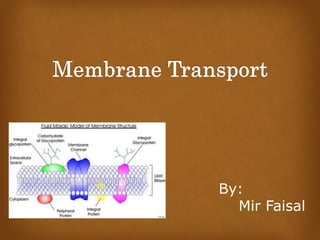Membrane transport
•Transferir como PPTX, PDF•
6 gostaram•2,048 visualizações
Basic intro into membrane transpoort
Denunciar
Compartilhar
Denunciar
Compartilhar

Recomendados
Mais conteúdo relacionado
Mais procurados
Mais procurados (20)
Sorting and sorting and regulation of intracellular transport

Sorting and sorting and regulation of intracellular transport
Semelhante a Membrane transport
Semelhante a Membrane transport (20)
Cell Membrane Transport/Factors/Transport of Substances

Cell Membrane Transport/Factors/Transport of Substances
transport_across_cell_membrane_cellular_transport.pptx

transport_across_cell_membrane_cellular_transport.pptx
Último
Último (20)
Bhiwandi Bhiwandi ❤CALL GIRL 7870993772 ❤CALL GIRLS ESCORT SERVICE In Bhiwan...

Bhiwandi Bhiwandi ❤CALL GIRL 7870993772 ❤CALL GIRLS ESCORT SERVICE In Bhiwan...
Selaginella: features, morphology ,anatomy and reproduction.

Selaginella: features, morphology ,anatomy and reproduction.
Biogenic Sulfur Gases as Biosignatures on Temperate Sub-Neptune Waterworlds

Biogenic Sulfur Gases as Biosignatures on Temperate Sub-Neptune Waterworlds
Module for Grade 9 for Asynchronous/Distance learning

Module for Grade 9 for Asynchronous/Distance learning
development of diagnostic enzyme assay to detect leuser virus

development of diagnostic enzyme assay to detect leuser virus
Call Girls Ahmedabad +917728919243 call me Independent Escort Service

Call Girls Ahmedabad +917728919243 call me Independent Escort Service
Human & Veterinary Respiratory Physilogy_DR.E.Muralinath_Associate Professor....

Human & Veterinary Respiratory Physilogy_DR.E.Muralinath_Associate Professor....
FAIRSpectra - Enabling the FAIRification of Analytical Science

FAIRSpectra - Enabling the FAIRification of Analytical Science
Pulmonary drug delivery system M.pharm -2nd sem P'ceutics

Pulmonary drug delivery system M.pharm -2nd sem P'ceutics
Porella : features, morphology, anatomy, reproduction etc.

Porella : features, morphology, anatomy, reproduction etc.
Use of mutants in understanding seedling development.pptx

Use of mutants in understanding seedling development.pptx
Membrane transport
- 2. • The phospholipid bilayer,(a bio-membrane) is normally impermeable to most water- soluble molecules, ions, and water itself. • O2 and CO2, and small, uncharged polar molecules,(ex: urea and ethanol),move by passive (simple) diffusion across an artificial membrane composed of mainly phospholipids and cholesterol. • The hydrophobicity of a substance given by partition coefficient K, is the ratio of its concentration within the hydrophobic region of the bilayer Cm to its concentration in the aqueous solution Caq). • The higher a substance’s partition coefficient, the more lipid-soluble it is. • The hydrophobicity of a molecule is, therefore directly proportional to its rate of diffusion across a pure phospholipid bilayer. Introduction
- 3. • Long chained Fatty acids are more hydrophobic than short chained fatty acids, therefore will diffuse more rapidly across a pure phospholipid bilayer. • The movement of substances carrying a net charge, is influenced by both its concentration gradient and the membrane potential, which as a whole is referred to as electrochemical gradient. • The electrochemical gradient, determines the energetically favourable direction for the transport the charged molecule across the membrane.
- 4. • Active Transport: ATP-powered pumps use the energy of ATP hydrolysis to transport ions and molecules across a membrane against a concentration gradient(Chemical/Electric). Facilitated diffusion: involves transport of water or specific ions via channel proteins and hydrophilic small molecules down their concentration or electric potential gradients Passive transport does not involve any chemical energy and relies on the difference in concentrations and of its component proteins and lipids. Protein-assisted transport reactions occur faster than that of passive diffusion, as they are substrate-specific. Transport mechanisms
- 5. Transporters/Carriers move a wide variety of ions and molecules across cell membranes Types of transporters: • Uniporters are involved in the transport of a single type of molecule down its concentration gradient by facilitated diffusion. Most mammalian cells use uniporters in the transportation of glucose and amino acids cross the bi-lipid layer(plasma membrane). • Antiporters execute coupled transport of two different molecules or ions through a membrane in opposite directions by a common carrier mechanism • Symporters also perform coupled transport of two different molecules or ions through a membrane in the same direction with the help of a common carrier mechanism Transporters
- 6. Antiporters and symporters are termed as cotransporters, as they transport two different solutes simultaneously. antiporters and symporters couple the movement of ions against the concentration gradient by transporting one or more types of ions down its concentration gradient. Co-transporters obtain energy stored in the electrochemical gradient unlike ATP pumps which use energy obtained from hydrolysis of ATP, this property of the co- transporters is termed as secondary active transport. Conformational changes are an essential property in the function of all transport proteins, this refers to the alteration in the tertiary structure of a protein as a result of binding of a ligand or of a substrate) The ATP-powered pumps and transporters experience conformational change exposing the binding site (or sites) to one side of the membrane,(Exoplasmic/Endoplasmic), in one conformation and alternates the exposed site during the second conformation.
- 7. The rate of facilitated diffusion by uniporters through a pure phospholipid bilayer is considerably higher than passive diffusion Transport occurs only through a few limited number of uniporter molecules, rather than molecules present throughout the phospholipid bilayer Transport is specific, i.e uniporter transports a single group of closely related molecules or only a single type of molecule. Difference between Uniport Transport & Passive Diffusion
- 8. The most widely studied uniporter is the glucose transporter GLUT1 found in the plasma membrane of erythrocytes. GLUT1
- 9. Like other uniporters, GLUT1 undergoes a conformational change. During the conformation, the glucose-binding site faces outward(Exoplasmic side); in the other, the binding site faces inward(cytoplasmic side). The glucose binds to the outward-facing site Triggering a conformational change in the uniporter that results in the binding site facing inward toward the cytosol. Glucose is then released into the cytosol of the cell. In the end, the transporter undergoes an inverted conformation, thereby reverting the uniport to face the original outward-facing binding site(towards the exoplasm) If the concentration of glucose is greater inside the cell, then the cycle will work in reverse Mechanism involved in GLUT1